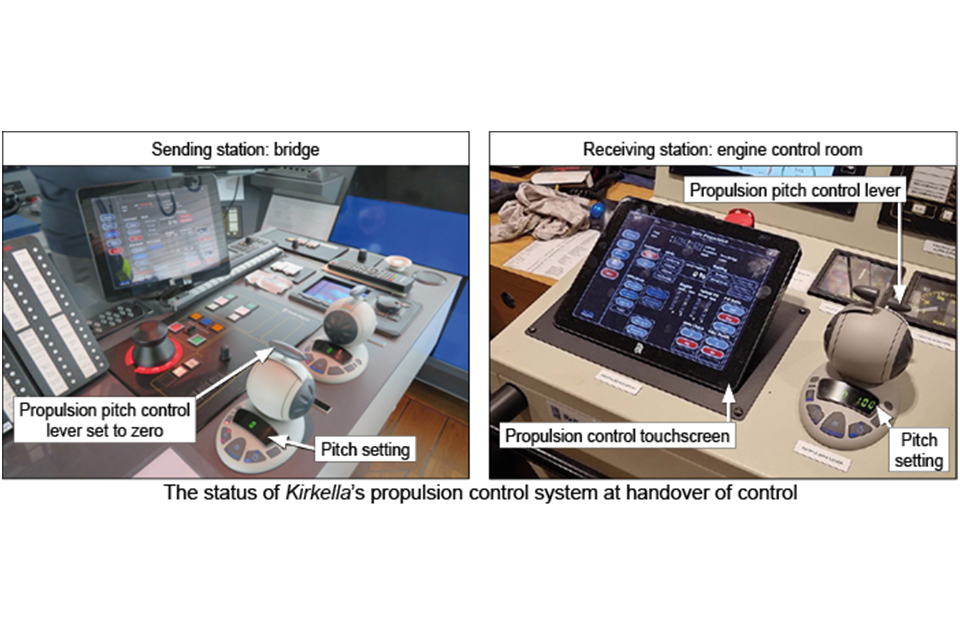Safety flyer to the shipping industry - Kirkella and Shovette
Published 13 June 2024
1. Summary
Loss of propulsion control identified following the collision between the fishing vessel Kirkella and harbour tug Shovette at King George Dock, Hull, England on 24 June 2022

2. Narrative
On 24 June 2022, the UK registered fishing vessel Kirkella lost control of its propulsion system while berthing and collided with the harbour tug Shovette in King George Dock, Hull, England. Kirkella’s bulbous bow breached Shovette’s hull and starboard fuel tank during the collision, causing the tug to partially sink and resulting in approximately 7,000 litres of marine diesel oil spilling into the dock. Kirkella was not damaged during the accident.
Kirkella’s propulsion system comprised a single main engine driving a controllable pitch propeller via a clutch and gearbox. The vessel’s propulsion was controlled by a Rolls-Royce Helicon-X3 integrated propulsion control system, supported by Kongsberg Maritime. The propulsion system could be operated from several stations located in the wheelhouse and from the engine control room (ECR). The loss of control occurred when the propulsion control was passed from the bridge to the ECR with the clutch engaged. At the time of the handover, the bridge propeller pitch lever was set at zero, while the ECR’s propeller pitch lever was set at 100% ahead (see figure). The propeller pitch automatically advanced when control was accepted in the ECR, causing Kirkella to move forward on the berth.

3. Safety lessons
-
The propulsion control system on Kirkella was not fitted with interlocks to prevent a mismatched propeller pitch lever position when control was transferred. Over 4,000 Rolls-Royce Helicon-X3 systems have been supplied to the industry, most of which were not fitted with optional interlocks, which were not required. Retrofitting can be undertaken by Kongsberg Maritime, as customer support provider.
-
Robust shipboard practices are essential to maintain propulsion control during handover, regardless of whether system interlocks are fitted. Documented procedures should contain a requirement for the operator of the sending station and the receiving station to check that propulsion systems pitch settings are aligned at the time of transfer.
-
To reduce the risk of propulsion thrust being applied inadvertently while alongside it is advisable to declutch engines before transfer of control.
4. Further information
Our accident investigation report is available at: https://www.gov.uk/maib-reports/collision-between-fishing-vessel-kirkella-and-pusher-tug-shovette.
Extract from The United Kingdom Merchant Shipping (Accident Reporting and Investigation) Regulations 2012 – Regulation 5:
The sole objective of the investigation of an accident under the Merchant Shipping (Accident Reporting and Investigation) Regulations 2012 shall be the prevention of future accidents through the ascertainment of its causes and circumstances. It shall not be the purpose of an such investigation to determine liability nor, except so far as is necessary to achieve its objective, to apportion blame.
Note:
This safety flyer is not written with litigation in mind and, pursuant to Regulation 14(14) of the Merchant Shipping (Accident Reporting and Investigation) Regulations 2012, shall be inadmissible in any judicial proceedings whose purpose, or one of whose purposes is to attribute or apportion liability or blame.
Marine Accident Investigation Branch
First Floor, Spring Place
105 Commercial Road
Southampton
SO15 1GH
Email [email protected]
Enquiries during office hours +44 (0)23 8039 5500

